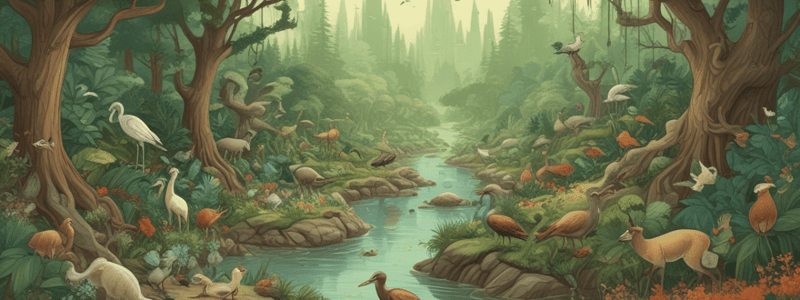Podcast
Questions and Answers
Match the following terms with their definitions:
Match the following terms with their definitions:
Interspecific interactions = Include competition, predation, & symbiosis (mutualism & parasitism) Diversity = Depends on survival of species & their relative abundance Ecology = Study of how environmental factors affect the distribution & abundance of species Biomes = Dictated by precipitation and temperature
Match the following concepts with their descriptions:
Match the following concepts with their descriptions:
Community ecology = Study between species that live in a community and how these interactions affect their distribution and abundance Population ecology = Focuses on studying groups of individuals of the same species living in a particular area Ecosystem ecology = Examines the interactions between living organisms and their physical environment
Match the following components with their roles in an ecosystem:
Match the following components with their roles in an ecosystem:
Ground squirrels, snakes, butterflies, trees, ants, bacteria, fungi = All of the species that potentially have interactions with one another Tides (high/upper tide, mid tide, low tide) = Create a unique environment for species to live in, like rocky intertidal communities
Match the following factors with their influence on biomes:
Match the following factors with their influence on biomes:
Match the following terms with their meanings:
Match the following terms with their meanings:
Match the following ecological terms with their definitions:
Match the following ecological terms with their definitions:
Match the following factors with their classification as abiotic or biotic:
Match the following factors with their classification as abiotic or biotic:
Match the following terms with their appropriate scale of ecological organization:
Match the following terms with their appropriate scale of ecological organization:
Match the following statements with the correct discipline in ecology:
Match the following statements with the correct discipline in ecology:
Match the following environmental factors with their impact on organisms:
Match the following environmental factors with their impact on organisms:
Match the following ecological levels of organization with their descriptions:
Match the following ecological levels of organization with their descriptions:
Match the following ecological studies with their primary focus:
Match the following ecological studies with their primary focus:
Match the following ecological concepts with their respective examples:
Match the following ecological concepts with their respective examples:
Match the following terms related to ecology with their definitions:
Match the following terms related to ecology with their definitions:
Match the following ecological levels with their scope:
Match the following ecological levels with their scope:
Flashcards are hidden until you start studying
Study Notes
Introduction to Ecology
- Ecology is the study of the abundance and distribution of organisms as shaped by environmental factors.
- Ecologists are interested in how biotic and abiotic factors influence the abundance and distribution of organisms.
Environmental Factors
- Abiotic factors: precipitation, sunlight, nutrients, weather patterns
- Biotic factors: predators, prey, mutualists, parasites, mates, any living organism that can influence other living organisms
Scales of Organization
- Organismal ecology (physiological ecology): how physiological processes of an organism dictate its distribution and abundance
- Population ecology: study of multiple individuals of the same species living in a location
- Community ecology: study of all species that live close enough in a location to interact
- Ecosystem ecology: study of living members of the community and abiotic components that interact with them
- Biosphere: the collection of all biomes on the planet
Community Ecology
- Study of interactions between species that live in a community and how these interactions affect their distribution and abundance
- Includes competition, predation, and symbiosis (mutualism and parasitism)
- Diversity depends on survival of species and their relative abundance
Ecosystem Ecology
- Includes the water cycle, carbon cycle, nitrogen cycle, fire, and any abiotic factor that affects the community
- Carbon cycle: carbon is a molecule that exists in different forms, is contained in living organisms, and is returned to the soil when they die
Biomes
- Dictated by precipitation and temperature
- Examples: rocky intertidal, poles, and other geographical areas
Rocky Intertidal
- A biome or environment for species to live in, characterized by tides (high/upper, mid, and low)
- Species that live here are adapted to live in both water and land
- Examples: species that live in the tidal area near the ocean
Studying That Suits You
Use AI to generate personalized quizzes and flashcards to suit your learning preferences.




